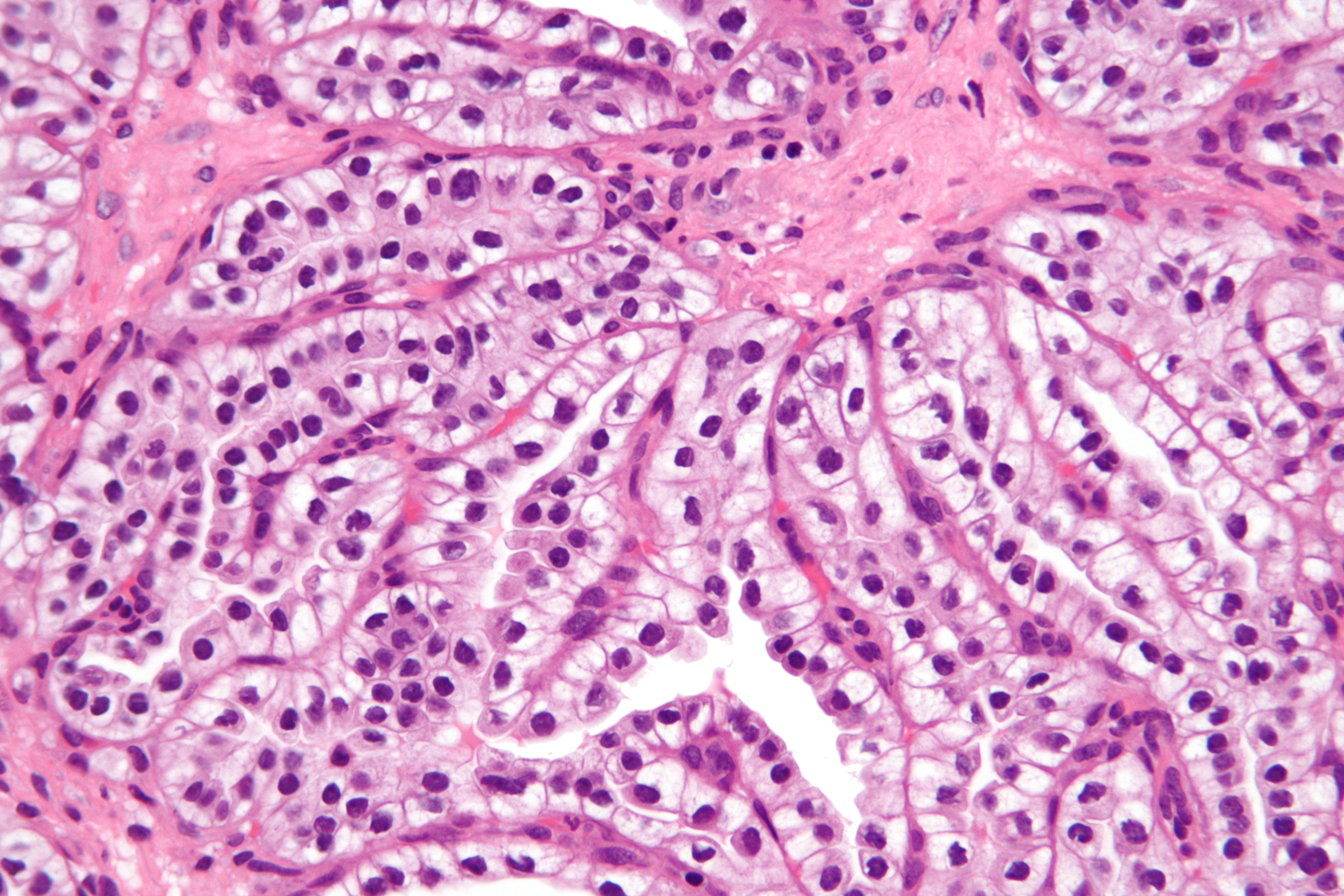Clear cell papillary renal cell carcinoma
Editor-In-Chief: Prab R Tumpati, MD
Obesity, Sleep & Internal medicine
Founder, WikiMD Wellnesspedia &
W8MD medical weight loss NYC and sleep center NYC
| Clear cell papillary renal cell carcinoma | |
|---|---|

| |
| Synonyms | Clear cell papillary RCC |
| Pronounce | N/A |
| Specialty | N/A |
| Symptoms | Often asymptomatic, may present with hematuria, flank pain, or a palpable mass |
| Complications | Rarely metastasizes |
| Onset | Typically in adults |
| Duration | Indolent |
| Types | N/A |
| Causes | Unknown |
| Risks | Chronic kidney disease, end-stage renal disease |
| Diagnosis | Histopathology, immunohistochemistry |
| Differential diagnosis | Clear cell renal cell carcinoma, papillary renal cell carcinoma |
| Prevention | N/A |
| Treatment | Surgical resection |
| Medication | N/A |
| Prognosis | Excellent, low risk of progression |
| Frequency | Rare |
| Deaths | N/A |
Clear cell papillary renal cell carcinoma (ccpRCC) is a distinct subtype of renal cell carcinoma (RCC) characterized by unique histological and genetic features. It was first described in the early 2000s and has since been recognized as a separate entity in the classification of kidney tumors. ccpRCC typically exhibits a favorable prognosis and has unique morphological characteristics that distinguish it from other types of RCC.
Epidemiology[edit | edit source]
The exact prevalence of ccpRCC is difficult to determine, as it was only relatively recently recognized as a distinct entity. However, it is considered to be a rare subtype of RCC. ccpRCC can occur in individuals of any age but is more commonly diagnosed in adults. There is no clear gender predilection.
Pathogenesis[edit | edit source]
The pathogenesis of ccpRCC is not fully understood. Unlike the more common clear cell RCC, which is often associated with mutations in the VHL gene, ccpRCC does not typically exhibit mutations in known cancer-associated genes. Its unique genetic and molecular profile suggests a different pathway of carcinogenesis.
Clinical Features[edit | edit source]
Patients with ccpRCC often present with incidental findings, as these tumors are usually asymptomatic in the early stages. When symptoms do occur, they may include hematuria (blood in the urine), flank pain, or a palpable mass in the abdomen. However, these symptoms are not specific to ccpRCC and can be associated with various renal conditions.
Diagnosis[edit | edit source]
The diagnosis of ccpRCC is primarily based on histological examination of the tumor tissue. Imaging studies such as ultrasound, computed tomography (CT) scans, and magnetic resonance imaging (MRI) can suggest the presence of a renal mass but cannot definitively diagnose ccpRCC. Histologically, ccpRCC is characterized by clear cells and papillary architecture, with cells arranged in a linear pattern along the basement membrane. Immunohistochemical staining is also used to differentiate ccpRCC from other subtypes of RCC.
Treatment[edit | edit source]
The treatment for ccpRCC typically involves surgical resection of the tumor. Nephron-sparing surgery, such as partial nephrectomy, is preferred to preserve renal function, especially in cases of small, localized tumors. For more advanced cases, radical nephrectomy may be necessary. The role of adjuvant therapies, such as targeted therapy or immunotherapy, in the treatment of ccpRCC is still under investigation, as this subtype generally exhibits a favorable prognosis and may not require aggressive treatment.
Prognosis[edit | edit source]
ccpRCC is generally associated with a favorable prognosis, especially when diagnosed at an early stage. The tumor tends to grow slowly and has a low potential for metastasis. The overall survival rate for patients with ccpRCC is higher compared to those with more aggressive subtypes of RCC.
Summary[edit | edit source]
Clear cell papillary renal cell carcinoma represents a unique subtype of renal cell carcinoma with distinct clinical, histological, and genetic characteristics. Its recognition as a separate entity has implications for diagnosis, treatment, and prognosis of patients with this condition. Ongoing research is necessary to further understand the pathogenesis of ccpRCC and to refine treatment strategies.
Search WikiMD
Ad.Tired of being Overweight? Try W8MD's physician weight loss program.
Semaglutide (Ozempic / Wegovy and Tirzepatide (Mounjaro / Zepbound) available.
Advertise on WikiMD
|
WikiMD's Wellness Encyclopedia |
| Let Food Be Thy Medicine Medicine Thy Food - Hippocrates |
Translate this page: - East Asian
中文,
日本,
한국어,
South Asian
हिन्दी,
தமிழ்,
తెలుగు,
Urdu,
ಕನ್ನಡ,
Southeast Asian
Indonesian,
Vietnamese,
Thai,
မြန်မာဘာသာ,
বাংলা
European
español,
Deutsch,
français,
Greek,
português do Brasil,
polski,
română,
русский,
Nederlands,
norsk,
svenska,
suomi,
Italian
Middle Eastern & African
عربى,
Turkish,
Persian,
Hebrew,
Afrikaans,
isiZulu,
Kiswahili,
Other
Bulgarian,
Hungarian,
Czech,
Swedish,
മലയാളം,
मराठी,
ਪੰਜਾਬੀ,
ગુજરાતી,
Portuguese,
Ukrainian
Medical Disclaimer: WikiMD is not a substitute for professional medical advice. The information on WikiMD is provided as an information resource only, may be incorrect, outdated or misleading, and is not to be used or relied on for any diagnostic or treatment purposes. Please consult your health care provider before making any healthcare decisions or for guidance about a specific medical condition. WikiMD expressly disclaims responsibility, and shall have no liability, for any damages, loss, injury, or liability whatsoever suffered as a result of your reliance on the information contained in this site. By visiting this site you agree to the foregoing terms and conditions, which may from time to time be changed or supplemented by WikiMD. If you do not agree to the foregoing terms and conditions, you should not enter or use this site. See full disclaimer.
Credits:Most images are courtesy of Wikimedia commons, and templates, categories Wikipedia, licensed under CC BY SA or similar.
Contributors: Prab R. Tumpati, MD


